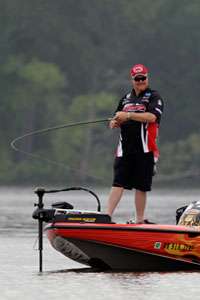
In honor of Toyota Trucks Championship week, we've picked the brains of several past Toyota Tundra Bassmaster Angler of the Year winners about their favorite seasonal techniques. First up to the plate is three-time TTBAOY (1995, 1998 and 2001) champion and 1995 Bassmaster Classic winner Mark Davis. He tells us how and where to use his two favorite late summer techniques, cranking and worming.
Creek Cranking
As the water cools slightly in the late summer, oxygen levels in the main lake become depleted. This forces fish and anglers alike to migrate to shallow water. The most likely place to find these shallow fish is in or at the back of creeks.
Davis says when searching for bass in creeks, you should look for one of two things: shad or contour changes in the bottom of the creek. The shad are a dead giveaway, and fish relate to the edges of submerged creek channels.
Depending on the composition of the creek, Davis will reach for either a lipless or square-billed crankbait. Both are excellent shad-imitators.
If there's wood like stumps, treetops or laydown logs, I'll go for a square-billed Strike King Series 4s (the 's' is for shallow) in Tennessee Shad if the water is clear or in chartreuse with a blue back if it's stained," he says. "If the bottom is clean or muddy or I'm fishing over vegetation, I go with a lipless Strike King Red Eye Shad in chrome with a blue back or a Sexy Shad color."
Davis throws both of these baits on a medium-action 7-foot All Star rod with a Pflueger Patriarch reel spooled with 12- to 14-pound test Stren monofilament. He goes with mono for its ease of handling and casting.
Worming Ways
When the bass aren't quite ready to move to the backs of creeks, Davis concentrates on 10 to 25 feet of water, depending on the overall depth of the lake.
He's looking to drag a 10-inch plum-colored Strike King Anaconda with a 3/8-ounce weight along secondary points, the outside of channel bends that head to a creek or in a channel dropoff. If none of these spots produce, he will head back out to main lake points. Davis doesn't do anything fancy here, he just drags the worm across the structure.
His casting rig consists of a 7-foot medium-heavy action All Star rod with the same Pflueger reel, but for worming duties he spools it with 20-pound test Stren fluorocarbon.
One of Davis' favorite things about fishing late summer is the predictability it offers.
"This time of year, the fish are pretty consistent. Once you pattern them, it doesn't change much day to day; you can stay with them easier," he says.
Follow the Moonlit Path
Another key part of later summer fishing is the moon phases. Davis says there is usually a window of a few hours when the bass will bite, and he has found that this is related to the moon phase.
"When the fish are biting best, it's critical to be where they are. Usually the best time is the week leading up to the full moon, especially the three days leading up it," he says. "During the full moon, the window may even be in the middle of the day, and if you fish too fast you may miss it, so it's critical to be out there."




